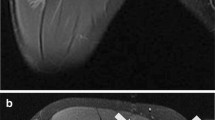Abstract
After sonographical examination with a 7.5-MHz linear array scanner, we created an experimental muscle injury of known sitze and location on 28 New Zealand white rabbits by stabbing them with a scalpel in the supraspinatus muscle. The changes in the healing process were followed and documented by sonography and magnetic resonance imaging (MRI) before and 2, 5, 11, 14, 36 and 64 days after injury. The changes in sonography and MRI followed a regular course. Ultrasound revealed an echo-poor area after injury with ever increasing echogenicity from the 14th day. Strong reflexes were found after 2 months. MRI showed few changes, only a slight increase of signal intensity, but a characteristic curve of calculated T2-times (a program of the MRI software). The interpretation of the sonographical picture in histopathological terms remained limited. The development of a hematoma and of fibrous scars can be followed up by sonography, but it is not possible to determine the point of time after injury very accurately. Nevertheless, sonography is a method of great value in the diagnosis of muscle injuries and, given certain limits, in the follow-up of the healing process, too. The significance of MRI can be increased by calculations with the implemented software, as in our study calculated T2-times produced a characteristic curve reflecting the shift of fluids after muscle injury.
Similar content being viewed by others
References
Cameron IL, Ord VA, Fullerton GD (1984) Characterization of proton MRT relaxation times in normal and pathological tissues by correlation with other tissue parameters. Magn Reson Imaging 2:97–106
Dock W, Grabenwöger F, Happak W, Steiner E, Metz V, Ittner G, Eber K (1990) Sonographie der Skeletalmuskulatur mit hochfrequenten Schallköpfen. RÖFO 152:47–50
Fisher BD, Baracos VE, Shnitka TK, Mendryk SW, Reid DC, (1990) Ultrastructural events following acute muscle trauma. Med Sci Sports Exerc 22:185–193
Fornage BD (1987) Échography du système musculo-tendineux des membranes. Atlas d' anatomic ultrasonoire normal. Vigot, Paris
Fornage BD, Touch DH, Segal P, Rifkin MD (1983) Ultrasonography in the evaluation of muscle trauma. J Ultrasound Med 2:549–554
Fullerton GD (1988) Physiologic basis of magnetic relaxation. In: Starck DD, Bradley WG (eds) Magnetic resonance imaging. Mosby, St. Louis
Hannesschläger G, Reschhauer R, Riedelberger W, Stadler R (1988) Hochauflösende Real-time-Sonographie bei sportspezifischen Muskelverletzungen. Sonomorphologische-anatomische Korrelation und diagnostische Kriterien. Sportverletz Sportschaden 2:45–54
Harcke HT, Grissom LE, Finkelstein MS (1988) Evaluation of the musculoskeletal system with sonography. AIR 150:1253–1261
Harland U (1988) Die Abhängigkeit der Echogenität vom Anschallwinkel an Muskel und Sehnengewebe. Z Orthop 126:117–124
Hicks JE, Shawker TH, Jones BL, Linzer M, Gerber LH (1984) Diagnostic ultrasound: its use in the evaluation of muscle. Arch Phys Med Rehab 65:129–131
Hunne T, Kalimo H, Lehto M, Järvinnen M (1991) Healing of skeletal muscle injury. An ultrastructural and immunohistochemical study. Med Sci Sports Exerc 23:801–810
Kresse H (1968) Der Einflur des Einfallswinkels bei der Ultraschall-Echodiagnostik. Elektromedizin, special edition
Laine HR, Harjula A, Peltokallio P (1985) Experience with real-time sonography in muscle injuries. Scand J Sports Sci 7:45–49
Mellerowicz H, Stelling E, Kiefenbaum A (1990) Diagnostic ultrasound in the athlete's locomotor system. Br J Sports Med 24:31–39
Pfister A (1987) Die Ultraschalldiagnostik bei sportorthopädischen Weichteilerkrankungen. Dtsch Z Sportmed 3: 107–110
Schröder JM (1987) Pathologie der Muskulatur. In: Doerr W, Seifert G (eds) Spezielle pathologische Anatomie, Vol. 15. Springer, Berlin Heidelberg New York
Sievers KW, Gauger J, Bauermann T, Löhr E (1993) Changes of soft-tissue water examined with magnetic resonance and electrical impedance tomography: an in vivo experiment. Angiology 44:11–14
Stauber WT, Fritz VK, Vogelbach DW, Dahlmann B (1988) Characterization of muscle injured by forced lengthening. I Cellular infiltrates. Med Sci Sport Exerc 20:345–353
Thermann H, Reimer P, Milbrandt H, Zwipp H, Wippermann B (1992) Sonographische Primärdiagnostik und Verlaufskontrolle von Muskel- und Sehnenschäden der unteren Extremität. Unfallchirurg 95:412–418
Wehrli FW (1988) Principles of magnetic resonance. In: Stark DD, Bradley WG (eds) Magnetic resonance imaging. Mosby, St. Louis
Author information
Authors and Affiliations
Rights and permissions
About this article
Cite this article
Küllmer, K., Sievers, K.W., Rompe, J.D. et al. Sonography and MRI of experimental muscle injuries. Arch Orthop Trauma Surg 116, 357–361 (1997). https://doi.org/10.1007/BF00433990
Received:
Issue Date:
DOI: https://doi.org/10.1007/BF00433990




